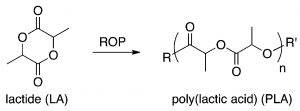Did you know that less than 11% of plastics have been recycled in Canada since the 1950s? Many plastics, such as water bottles, bags, and takeaway coffee cups, are buried in landfills and are disposed of into the oceans.
Over a long period of exposure to air, sunlight, and moisture, they eventually “disappear” – becoming invisible to the naked eye. In this case, are plastics degradable? While we may use the word “degradation”, they do not actually disappear. The invisible ones have taken the form of microplastics, thereby still existing and still polluting our ecosystem.
Video clip 1. Microplastics as a food for baby fishes.
To mitigate this issue, chemists have made an effort to develop biodegradable polymers that can be applied to produce commercial plastics. In modern polymer chemistry, considerable attention has been paid to polylactic acid, so-called PLA. Polylactic acid is produced from lactide which is derived from renewable resources such as corn and potato starch.
 Figure 1. Chemical structures of lactide (monomer) and polylactic acid (polymer) . ROP stands for ring-opening polymerization (a type of polymerization). DOI:10.1021/acs.accounts.7b00447
Figure 1. Chemical structures of lactide (monomer) and polylactic acid (polymer) . ROP stands for ring-opening polymerization (a type of polymerization). DOI:10.1021/acs.accounts.7b00447
Unlike petroleum-based polymers used in plastics such as polyethylene (PE), polyethylene terephthalate (PET), and polypropylene (PP), PLA has biodegradability and biocompatibility.The enriched oxygen atoms in PLA and its structural flexibility make it undergo hydrolytic and enzymatic degradations, regenerating monomers and oligomers. The degraded substances are further broken down to water and carbon dioxide, precluding the formation of microplastics. Therefore, PLA is a great candidate to substitute for plastics derived from petroleum sources.
Although there are some general issues to resolve from an economical perspective, the environmentally friendly outcomes and industrial applications have made PLA a more attractive material for plastics PLA certainly has the potential to save our future!
-Young Cho


